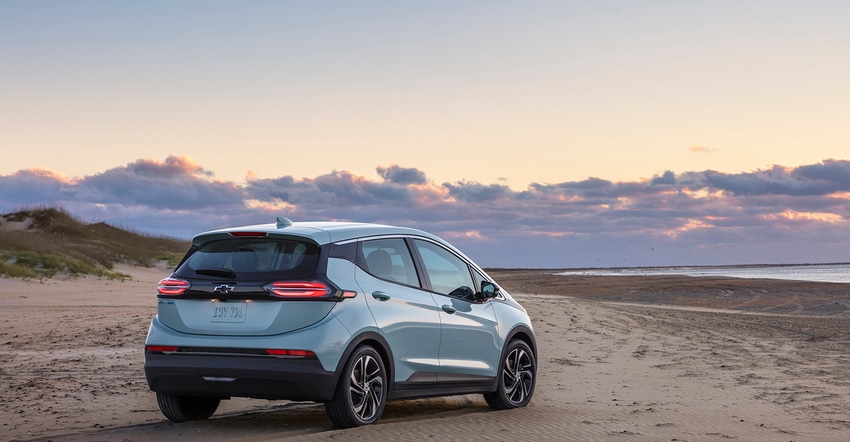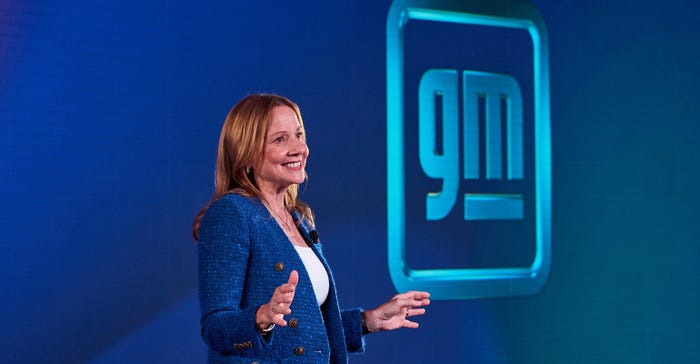GM to Axe the Chevy Bolt, Invest $3 Billion in Battery Plant with Samsung SDI
General Motors has big EV and battery plans—but they won’t include the Bolt, the company’s best-selling EV.

General Motors will end production of the Chevrolet Bolt by the end of 2023, CEO Mary Barra announced to investors on Tuesday. The news that the company will discontinue making the car that has made up the bulk of its EV sales to date follows the company’s announcement in March that it is seeking buyouts from most of its 58,000 salaried workforce.
Looked at in isolation, those developments might make one worry for the company’s electrification plans. No need, according to a casual Barra—who, according to Yahoo Finance reporter Pras Subramanian, dropped the Bolt news “as almost an aside.”
The suburban Detroit plant that has been making the Bolt is to be retooled for production of other EVS—namely the electric Chevrolet Silverado and GMC Sierra trucks, she said. And unlike the Bolt, the newer EVs will be based on GM’s Ultium battery architecture.
“We plan to produce 400,000 EVs over the course of 2022, 2023, and the first half of 2024, including 50,000 EVs in North America in the first half of this year, and double that in the second half,” Barra wrote in her letter to investors and on a LinkedIn post:
“In the weeks and months ahead, we will be sharing exciting news about our growing portfolio of Chevrolet, Buick, GMC, Cadillac and BrightDrop EVs. This includes demonstrating that ‘work’ and ‘range’ are not mutually exclusive terms for the Chevrolet Silverado EV and GMC Sierra EV.”

New US battery manufacturing plant with Samsung SDI is coming—somewhere
And if that wasn’t enough to assuage worries about its electrified future, the company announced the same day that it plans to invest, with Samsung SDI, more than $3 billion to build a new battery cell manufacturing plant in the United States that is targeted to begin operations in 2026.
“GM’s supply chain strategy for EVs is focused on scalability, resiliency, sustainability, and cost-competitiveness. Our new relationship with Samsung SDI will help us achieve all these objectives,” stated Barra. “The cells we will build together will help us scale our EV capacity in North America well beyond 1 million units annually.”
The plant will have more than 30 GWh of capacity and will bring GM’s total US battery cell capacity to about 160 GWh when it is at full production.
The companies plan to jointly operate the facility, and it is projected to have production lines to build nickel-rich prismatic and cylindrical cells.
The carmaker and the battery maker were not ready to announce the location of the new plant, however. “GM and Samsung SDI are not announcing the location of the plant or employment projections at this time, however, the number of new jobs in construction and operations are expected to number in the thousands,” the GM news release stated.
The Bolt goes the way of the Volt
By ending production of the Bolt, GM is continuing its practice of letting go of an EV model that has outlasted its purpose, despite its recent stronger-than-ever sales.
“There’s irony in the timing of the Bolt getting axed,” noted CNBC’s Michael Wayland. “It comes amid record production and sales of the vehicle for mass-market consumers, which was GM’s initial goal.”
The Bolt was designed to be the first major EV model that could compete with ICE models for mainstream drivers, in competition with Tesla’s Model 3. But technology has moved on since then.
“When the Chevrolet Bolt EV launched, it was a huge technical achievement and the first affordable EV, which set in motion GM’s all-electric future,” Chevrolet spokesperson Cody Williams stated. “Chevrolet will launch several new EVs later this year based on the Ultium platform in key segments, including the Silverado EV, Blazer EV, and Equinox EV. ”
GM’s decision to end the Bolt has a familiar echo. In 2019 the company ended production of the Chevy Volt, its plug-in hybrid that though it didn’t sell as hoped, was immensely beloved by the drivers who did buy it. (This writer has two personal friends who own Volts—each of whom will, given the chance, rhapsodize its great qualities and bemoan its end.)

But then, as now, GM was ready to pull the plug—the pun is unavoidable—on an EV in order to better implement newer technology. The Volt ended its run with a range of about 50 miles before the gasoline-driven generator needed to kick in; the Bolt, in contrast, cost less to make and, according to the EPA, could go 259 miles on a full charge.
And according to GM, its new EVs that use the Ultium battery platform will be able to go a minimum of 300 miles on a charge.
Editor's note: Click here for a gallery of other discontinued EVs.
About the Author(s)
You May Also Like





